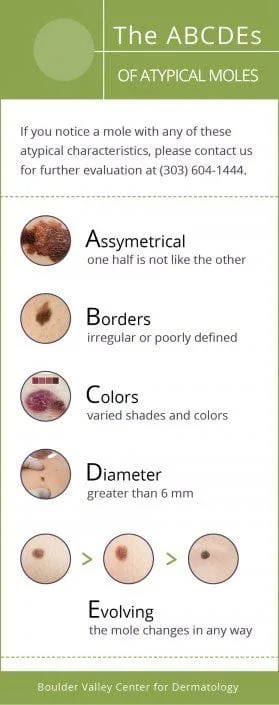Moles
Seeking treatment for unsightly or atypical moles? We can help.
Moles are also known as melanocytic nevi. A melanocyte is a cell in your skin that produces a substance called melanin, which is a pigment. Moles are due to the local proliferation of these pigment cells.

Moles can be present at birth or they can appear later in life. If they are present at birth, or if they appear in the first few months of life, they are called congenital moles. For congenital moles, the lesion will grow as the child grows: but it is important to be sure the mole is growing only in proportion to the growth of the child and not faster than that. Acquired moles can be induced by sun exposure, and it is normal to acquire new moles up until the age of about 35. In terms of appearance, moles can:
- Be raised or flat.
- Include many different colors like brown, tan, black, blue, pink and flesh-colored.
- Be several millimeters to several centimeters in size.
- Have hair growing out of them, called terminal hairs (actually a reassuring sign!).
Treatment: What to Expect
We remove atypical moles using a brief, painless outpatient procedure performed with local anesthesia. It takes around 20 minutes. Here’s what to expect:
- We will mark, clean, numb and drape the area for excision.
- We will remove the mole with about 2-3 mm of normal skin on either side. Depending on the size, the excision site may require a few stitches. In order for the skin to close without puckering (so it is flat), we make the incision about three times longer than the mole (for a 0.5 cm mole, the incision is 1.5 cm).
- We send the excised mole to CU’s Dermatopathology Lab for evaluation.
- In the vast majority of cases, no further treatment is needed.
- If the dermatopathology evaluation indicates any concerns, we will contact you for follow up.
Most moles are not harmful, but new, growing or changing moles should always be evaluated.
Call us at (303) 604-1444.
When To Call Us
The vast majority of moles are benign and do not require treatment. However, when moles are atypical they should be evaluated. Use the ABCDE method in the infographic here to consider your moles. If a mole has any of these atypical characteristics, or if you notice new or changing moles on your body, be sure to contact us for further evaluation.
If you are over the age of 40, it is the official recommendation of this office, as well as the American Academy of Dermatology, that you have a total body skin screening annually. We also recommend self-monitoring at home. If it helps, you can take photos of your moles each month and compare them to note any changes.